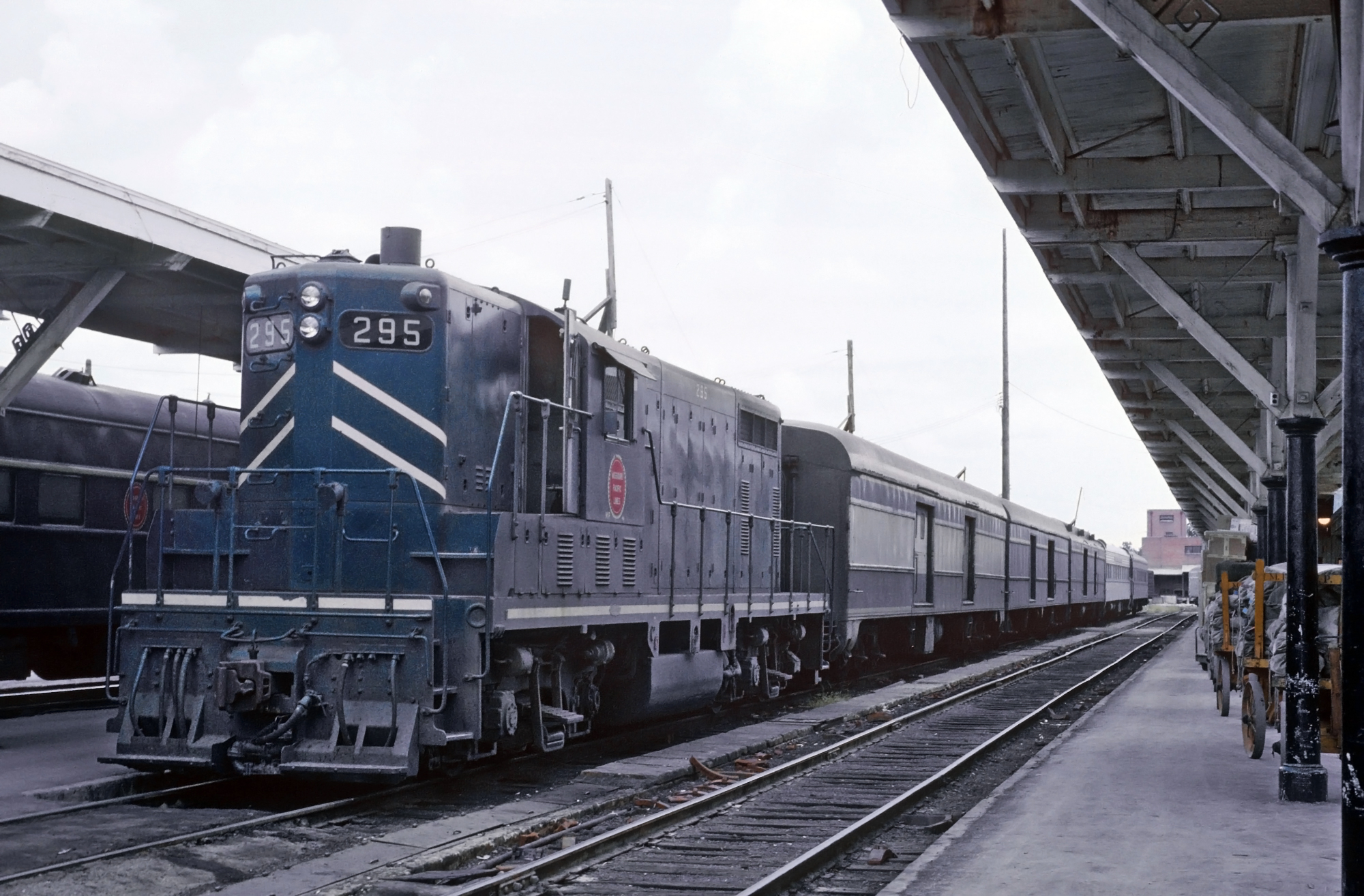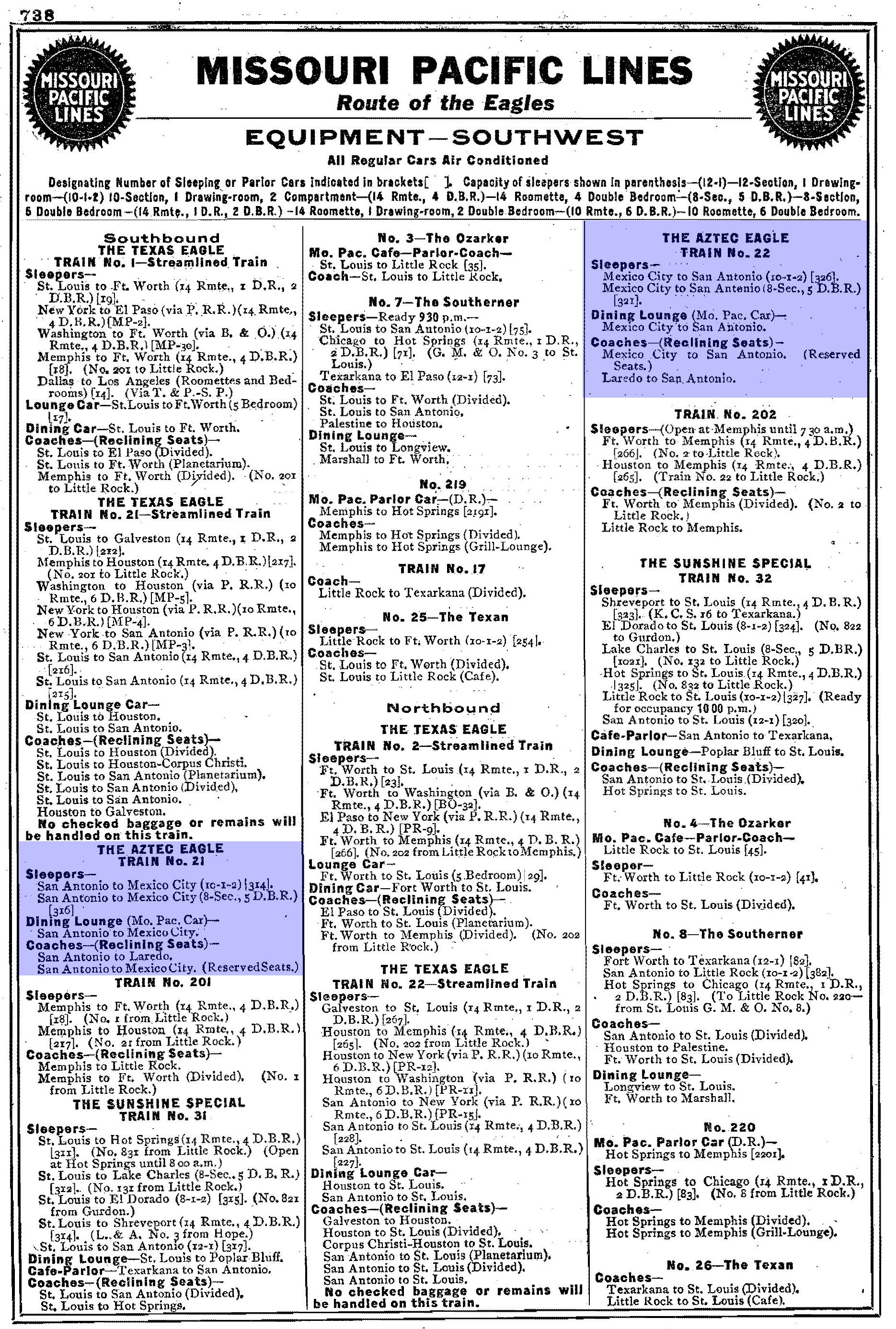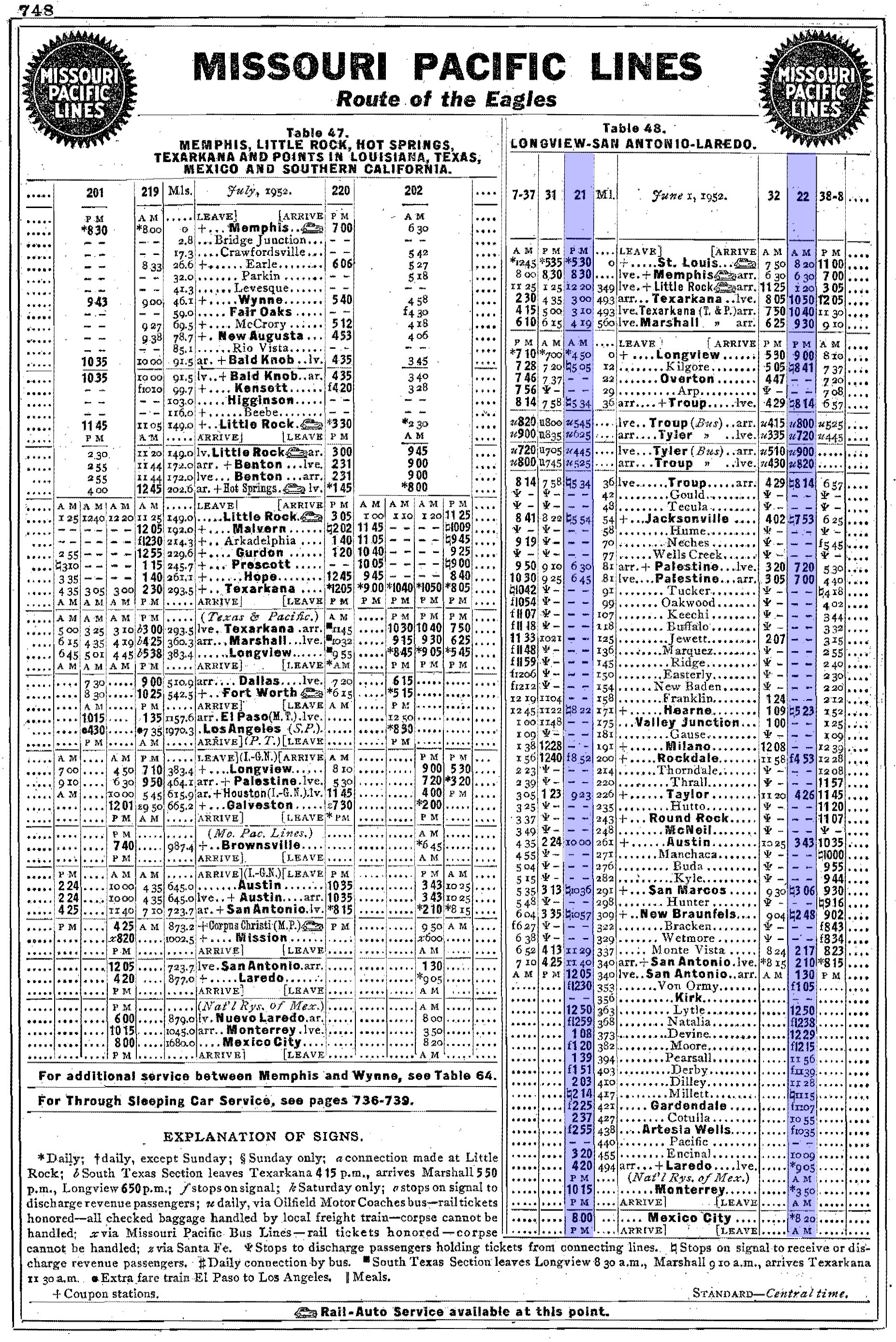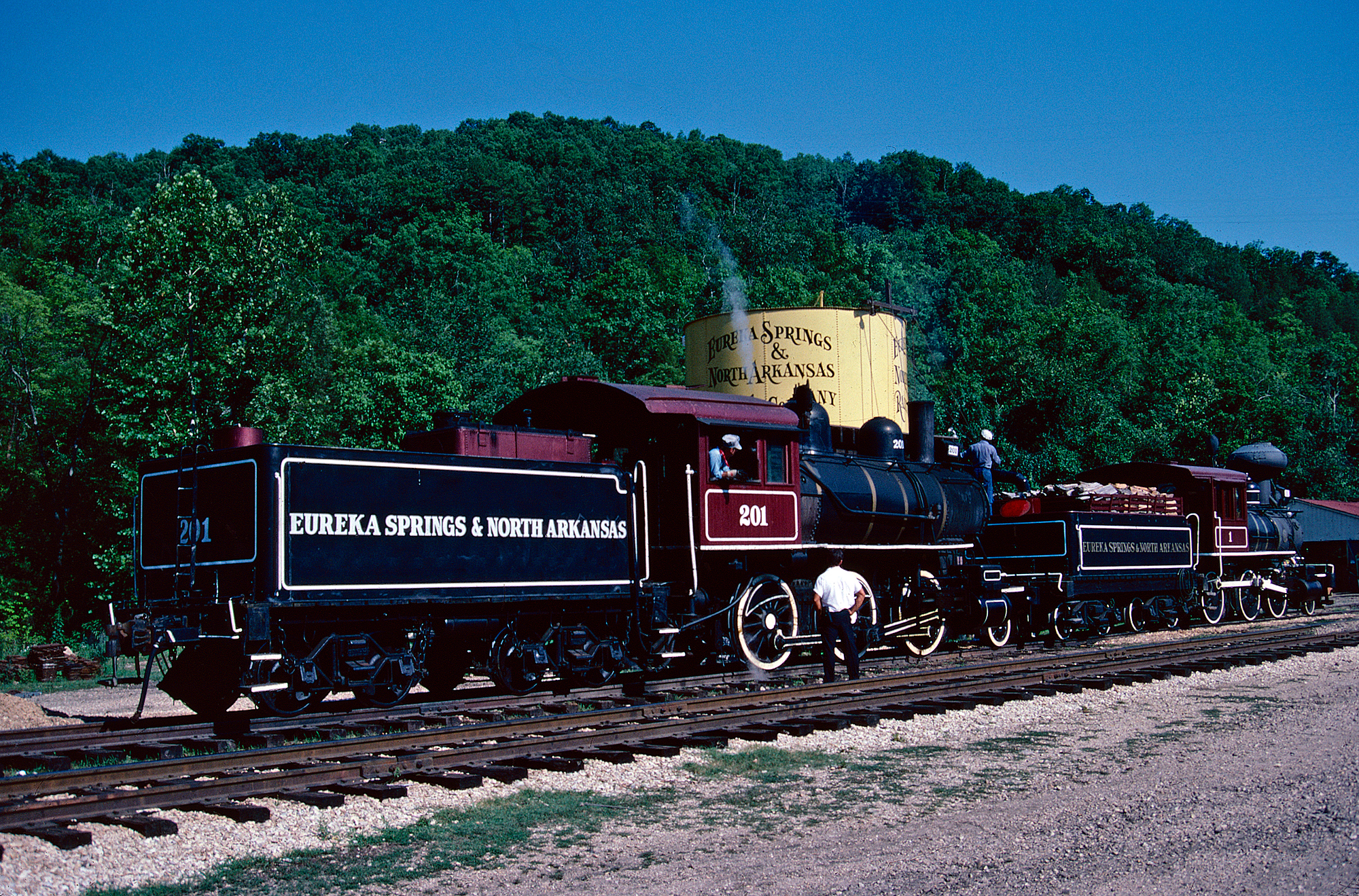"Aztec Eagle" (Train): Route, Consist, Timetable
Last revised: February 25, 2025
By: Adam Burns
The Aztec Eagle (or Águila Azteca) was a passenger train service operated by Ferrocarriles Nacionales de México (National Railways of Mexico) and Missouri Pacific between San Antonio, Texas and Mexico City, Mexico via Nuevo Laredo, near the United States border.
The service, which began in the 1940s, was named after the Aztec Eagle warriors, an elite group of soldiers in the Aztec Empire. The train was known for its scenic route, passing through deserts, mountains, and several historic sites.
The two railroads had provided some type of through service between the two cities since 1915 although the name Aztec Eagle was not adopted until 1948.
While the Missouri Pacific was largely always reluctant to send its streamlined, lightweight cars into Mexico the two carriers continued to operate the service until 1968-1969.
Photos
 Missouri Pacific GP7 #295 has what remains of the "Aztec Eagle" at San Antonio, Texas on September 6, 1966. Roger Puta photo.
Missouri Pacific GP7 #295 has what remains of the "Aztec Eagle" at San Antonio, Texas on September 6, 1966. Roger Puta photo.Inauguration
The Missouri Pacific's Aztec Eagle is a remarkable chapter in the history of American railroads, replete with details that capture the essence of international relations, trade, and travel during the first half of the 20th Century.
This magnificent train offered premier passenger service between St. Louis and Mexico City, demonstrating the collective ambition of two nations and three rail companies.
However, while through cars into Mexico was not unusual during the streamliner era, maintaining a through train was relatively uncommon.
While the MoPac and NdeM had been handling through cars via Laredo and Nuevo Laredo as early as 1915, the Aztec Eagle name did not appear until 1948 when the former began expanding its Eagle fleet after the war.
Notably, the train is distinguished by its classically-styled heavyweight, or modernized heavyweight, equipment. Although most American railroads upgraded to sleek, streamlined cars during the late 1940s and 1960s, the Aztec Eagle never ran with a full consist of lightweight equipment north of the border.
This was largely due to the MP management's uneasiness regarding sending its new cars south of Laredo. As a result, Greg Stout notes in his book, "Route Of The Eagles: Missouri Pacific In The Streamlined Era," the train was never the grand streamliner as many envision.
Nevertheless, it comfortable accommodations, that even included streamlined equipment via the NdeM.
Consist (August, 1952)

In 1952 the Mexican line upgraded its leg of the trip with streamlined cars from a Swiss railcar manufacturer known as Schlinder. The equipment did not carry quite the aesthetic appeal of American-built cars but it was nevertheless attractive.
Altogether, NdeM acquired three complete trainsets which included:
- One mail-baggage car.
- One 84-seat coach.
- Two 56-seat coaches.
- One diner.
- Two 8-sections/3 double-bedroom sleepers.
- One 10-room sleeper
- Finally, what was described as a Bar Observation.
The Missouri Pacific did not heavily promote the Aztec Eagle, but nevertheless did its best to provide the train with respectable service.
While St. Louis was the train’s American origin, as part of the Texas Eagle - a city known as the Gateway to the West - the Aztec Eagle could rightly be termed the Gateway to the South.
The journey itself was roughly 1,700 miles, the longest continuous rail journey in North America at the time. The train loaded at San Antonio and then moved onwards to the border station of Laredo, Texas, where NdeM took over the locomotive duties for the final stretch into Mexico City.
The route passed through the agricultural-rich flatlands of Texas, the arid northern Mexican deserts, the lush tropical rainforests of the Sierra Madre Mountains, and finally onto the high plateau where Mexico City is located. This journey was not just a means to an end, but a breathtaking tour through diverse climatic and geographical environments.
Interestingly, as Mr. Stout notes, the MP did paint some equipment into NdeM colors, such as 12-1 Pullman sleeper Armington which was given a red and cream livery in the ealry 1960s.
Decline
Unfortunately, with the advent of more accessible global air travel and the decline of the railroad industry, the Aztec Eagle struggled to maintain its relevance, at least under Missouri Pacific.
By the 1950s, the train's ridership had reduced significantly; in June, 1959 MP dropped the southbound grill-coach between San Antonio and Laredo but included the service on the northbound run.
Ironically, the service did enjoy a slight upgrade in December, 1960 when the train received a lightweight, 10 roomette-5 double bedroom Pullman sleeper at that time.
During its final decade the train was hardly a noteworthy service; it typically ran with a GP7 on the head-end, three mail/express cars, coach service, and a 10 roomette-6 double bedroom Pullman sleeper (St. Louis-Mexico City). By then, dining service was provided only via the NdeM.
In 1962, the Aztec Eagle was given new train numbers 1-2, which retained until service was suspended. While President Downing Jenks understood the problem of continuing to provide passenger trains by that time he nevertheless believed in maintaining top quality service until the end, as author Craig Miner notes in his book, "The Rebirth Of The Missouri Pacific, 1956-1983."
Despite the company's best efforts, it lost $9 million on these services in 1961, a figure which had jumped to $12 million the following year. The railroad attempted - but struggled - to remove additional trains that decade due to the Interstate Commerce Commission's refusal to do so.
By the latter half of the decade, however, it was finally able to do so; it canceled six trains in 1966 and combined four others, which offered a $500,000 annual savings. In 1968 it dropped an additional fourteen trains.
On December 31, 1968 all sleeping service ended on remaining trains. This decision was the final blow for the Aztec Eagle, and the Missouri Pacific's leg of this parternship ended with little fanfare on January 16, 1969.
Timetable (August, 1952)
Legacy
However, the Aztec Eagle lives on in the hearts of railroad enthusiasts and historians as one of Missouri Pacific's greatest footprints in the world of passenger rail service.
Worthy to remember too is that the Aztec Eagle ran during a transformative era—in the tick of the Great Depression, the throes of World War II, and the ensuing Cold War tension. Its existence reflects both the hope and turbulence characteristic of the times.
Ultimately, the Aztec Eagle, in its glory, was more than just a passenger train making its journey from St. Louis to Mexico City. It was a symbol of connection, a testament to transnational cooperation, and a cherished piece of railroad history that traversed across two countries, various landscapes, and many generations.
Sources
- Miner, Craig H. Rebirth Of The Missouri Pacific, 1956-1984, The. College Station: Texas A&M University Press, 1983.
- Schafer, Mike. Classic American Railroads. Osceola: MBI Publishing, 1996.
- Schafer, Mike and Welsh, Joe. Streamliners, History of a Railroad Icon. St. Paul: MBI Publishing, 2003.
- Stout, Greg. Route Of The Eagles: Missouri Pacific In The Streamlined Era. Kansas City: White River Productions, 1995.
Recent Articles
-
Arizona Railroad Museums: A Complete Guide
Apr 16, 25 01:17 PM
Learn about Arizona's rich history with railroads at one of several museums scattered throughout the state. More information about these organizations may be found here. -
Arkansas Railroad Museums: A Complete Guide
Apr 16, 25 12:59 PM
The state of Arkansas is home to a handful of small railroad museums. Learn more about these organizations here. -
Alabama Railroad Museums: A Complete Guide
Apr 16, 25 12:30 PM
Alabama, with its storied past and vibrant connection to the railroad industry, is home to several captivating railroad museums.


